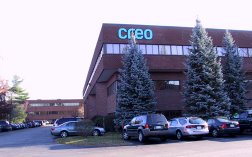Will Scitex buy Nur Macroprint?
Will Scitex Buy Nur Macroprint?
(Source: The-Marker, by Sophie Shulman 19 Feb 2003)
One thing is clear: Nur Macroprinters (Nasdaq:NURM)
needs to resolve its commercial and financial problems fast. Two years back, the
company, which develops wide and superwide format printers, borrowed money from
banks Hapoalim (TASE: POLI ), Leumi (TASE: LUMI ) and United Mizrahi (TASE: MZRH).
It borrowed the money in order to buy the American company Salsa, which was
supposed to help distribute Nur products in the U.S. The acquisition succeeded,
but the patient died: The American printing market is moribund and Nur is
suffering from imploding revenues on top of its $36 million debt.
Scrabbling for solutions, Nur has been talking with a succession of potential
investors that could shore up its finances, help it contend with the recession
and with intensifying competition. This week the Israeli media has reported
assessments of a looming takeover, but nothing has been signed so far.
One such plea targeted the investment company run by Israeli investors Boaz
Dotan and Yossi Ben Shalom. That came to nothing. Nur also turned to First
International Mezzanine Investors, a fund run by Shai Davidi, but that looks
unlikely to come to anything either. “We aren’t in the deal,” Davidi told
Ha’aretz on Tuesday. Not daunted, Nur is also negotiating with IES, an
investment company belonging to Haim Ger. Creo Products is also reportedly
sniffing at the hapless Israeli company.
“A merger would be a good option for Nur, at this point in time,” says analyst
Daniel Meron, who covered the company for Piper Jaffray. “Unless it merges or
gets an investment, Nur won’t have the financial flexibility to make moves that
could support growth and help it tackle the competition in the wide format
printing market.”
Nur did not rebuff the locals, either. It had considered uniting forces with its
veteran rival, Scitex Vision,
a Scitex Corporation (Nasdaq:SCIX) unit. That potential marriage frayed over
disagreement on Nur’s valuation for a deal, but any chances were killed by the
September 11, 2001 attacks on the U.S., which sent the American printing market
into the freezer. The result was a steep decline in Nur’s share price.
Nur. Looking for somebody
The market is playing with figures that Nur could command, but the truth is that
nobody would want to pay say $5 million for the pleasure of undertaking a $30
million debt, one market source pointed out.
Most of its debt is long-term, coming due in 2005. Only $5 million is
short-term. The banks already relaxed the terms of Nur’s loans, but probably
won’t repeat the favor, given Nur’s current condition. “Nur can’t show up at the
bank and say it wants rescheduling because there’s no improvement in its market,
and no reason for the banks to agree,” said a capital market source. ?The only
way to improve its terms would be to press a gun to the banks’ heads.”
Eroding profits
It isn’t just adverse market conditions, it’s the competition, stupid. The
fiercest competition is over disposables ? ink and materials, resulting in lower
and lower prices. In the past disposables generated much of Nur’s profitability,
because the margins are higher than on machinery. But the narrowing margins
reduced Nur to a loss of $1.2 million in the third quarter of 2002, and to a
negative cash flow.
Meron sees Nur’s key problem being Scitex Vision growing strength. Its ink heads
suit Nur printers, he points out, and being cheaper, gnaw at Nur’s market share.
But Itai Halevi, Scitex Vision’s business development and marketing
manager, rejects these assessments. The worst competition is coming from
companies that produce only disposable items, he argues, that imitate the
products made by the printer makers. “Nur, which had the biggest base of
installations, was a key target for the attack of counterfeiters, which is why
it got hurt,” Halevi says. “Scitex Vision adopted an aggressive pricing policy
in advance, meant to prevent the counterfeiters from targeting our printers, but
Nur lost a lot of its ink sales.”
Halevi does not see the merger of Scitex Vision with Aprion as causing Nur’s
difficulties. The merger was finalized just a month and a half ago, he says, and
it will take a year or two before the two companies come out with a joint
product.
Aprion develops unique ink injection technology, significantly expediting
wide-format printing processes and packaging printing.
Meron sees Nur having difficulty competing with the combo Scitex Vision-Aprion
printer. It will have to find new markets or products in order to survive, he
predicts.
Meanwhile, Nur is having difficulty selling its most recent printer, the Fresco.
Third-quarter income dwindled to $20.9 million, down 31% from the parallel
quarter and 11% from the second quarter. Nur hasn’t published its fourth-quarter
results yet, but the market isn’t expecting any improvement. Hence the drop in
Nur’s market cap to a mere $6 million.
Two fine companies:



 The Scitex 2002 Annual General Meeting will be held on Sunday, December 29, 2002 at 1:00 P.M. (Israel time) at the offices of the Company, 3 Azrieli Center, Triangle Building, 45th Floor, Tel Aviv, Israel.
The Scitex 2002 Annual General Meeting will be held on Sunday, December 29, 2002 at 1:00 P.M. (Israel time) at the offices of the Company, 3 Azrieli Center, Triangle Building, 45th Floor, Tel Aviv, Israel.